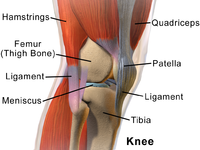
Photo from wikipedia
Periprosthetic joint infections (PJIs) are a devastating complication that occurs in 2% of patients following joint replacement. These infections are costly and difficult to treat, often requiring multiple corrective surgeries… Click to show full abstract
Periprosthetic joint infections (PJIs) are a devastating complication that occurs in 2% of patients following joint replacement. These infections are costly and difficult to treat, often requiring multiple corrective surgeries and prolonged antimicrobial treatments. The Gram-positive bacterium Staphylococcus aureus is one of the most common causes of PJIs, and it is often resistant to a number of commonly used antimicrobials. This tolerance can be partially attributed to the ability of S. aureus to form biofilms. Biofilms associated with the surface of indwelling medical devices have been observed on components removed during chronic infection, however, the development and localization of biofilms during PJIs remains unclear. Prior studies have demonstrated that synovial fluid, in the joint cavity, promotes the development of bacterial aggregates with many biofilm-like properties, including antibiotic resistance. We anticipate these aggregates have an important role in biofilm formation and antibiotic tolerance during PJIs. Therefore, we sought to determine specifically how synovial fluid promotes aggregate formation and the impact of this process on surface attachment. Using flow cytometry and microscopy, we quantified the aggregation of various clinical S. aureus strains following exposure to purified synovial fluid components. We determined that fibrinogen and fibronectin promoted bacterial aggregation, while cell free DNA, serum albumin, and hyaluronic acid had minimal effect. To determine how synovial fluid mediated aggregation affects surface attachment, we utilized microscopy to measure bacterial attachment. Surprisingly, we found that synovial fluid significantly impeded bacterial surface attachment to a variety of materials. We conclude from this study that fibrinogen and fibronectin in synovial fluid have a crucial role in promoting bacterial aggregation and inhibiting surface adhesion during PJI. Collectively, we propose that synovial fluid may have conflicting protective roles for the host by preventing adhesion to surfaces, but by promoting bacterial aggregation is also contributing to the development of antibiotic tolerance.
Journal Title: PLoS ONE
Year Published: 2020
Link to full text (if available)
Share on Social Media: Sign Up to like & get
recommendations!